
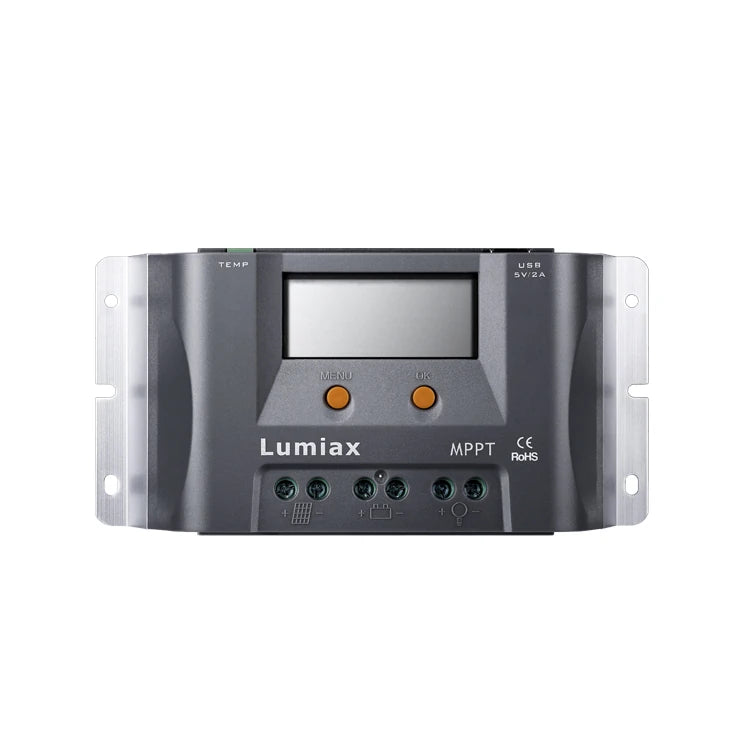
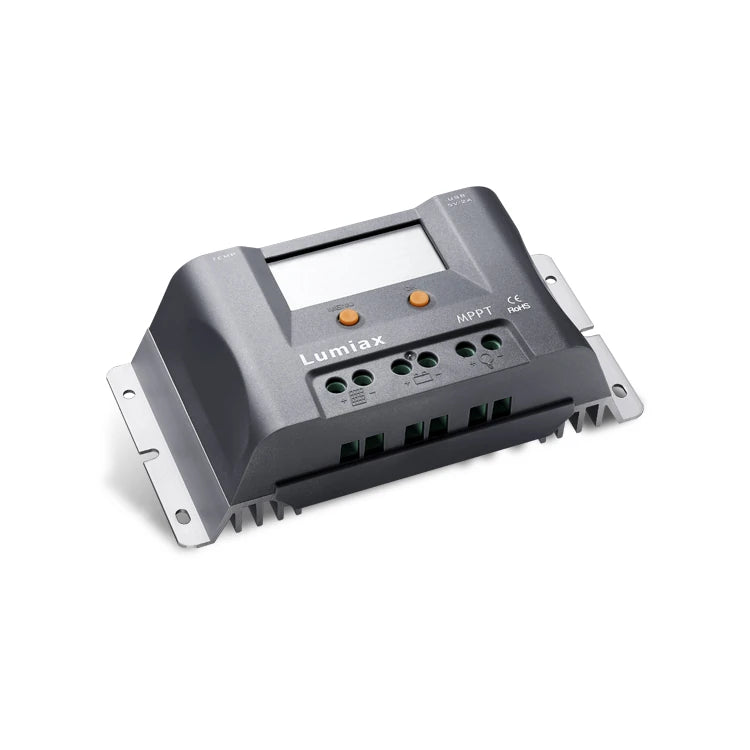
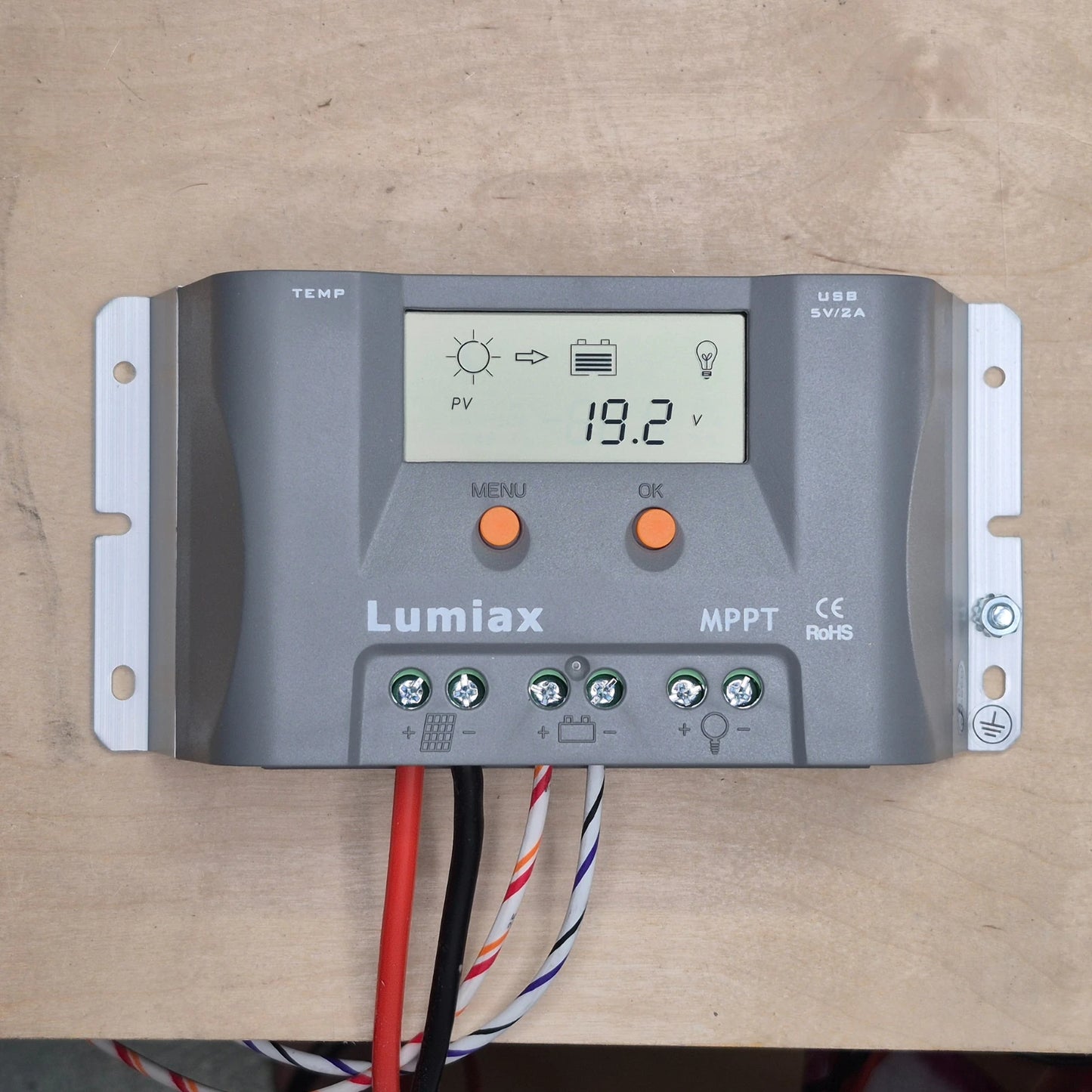
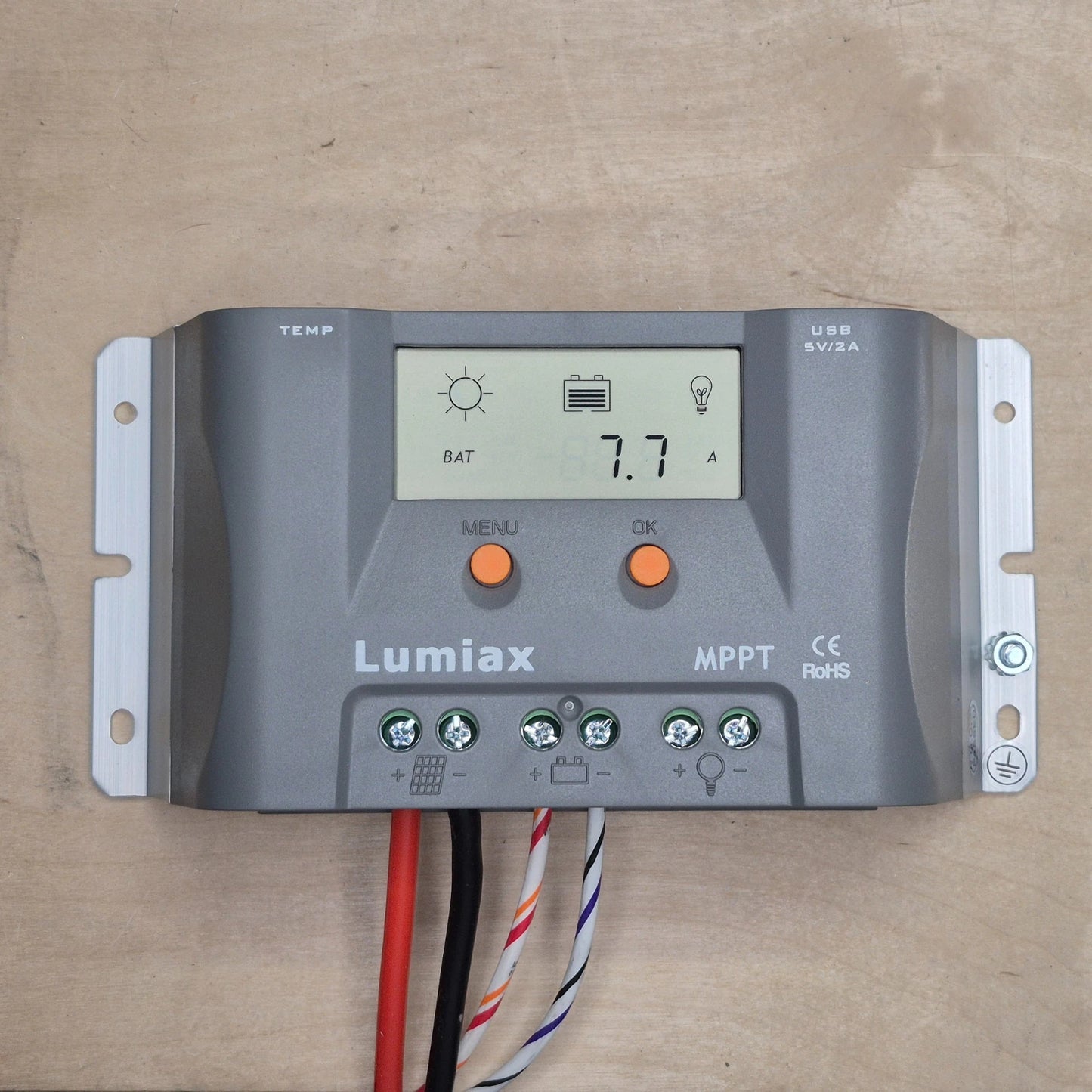

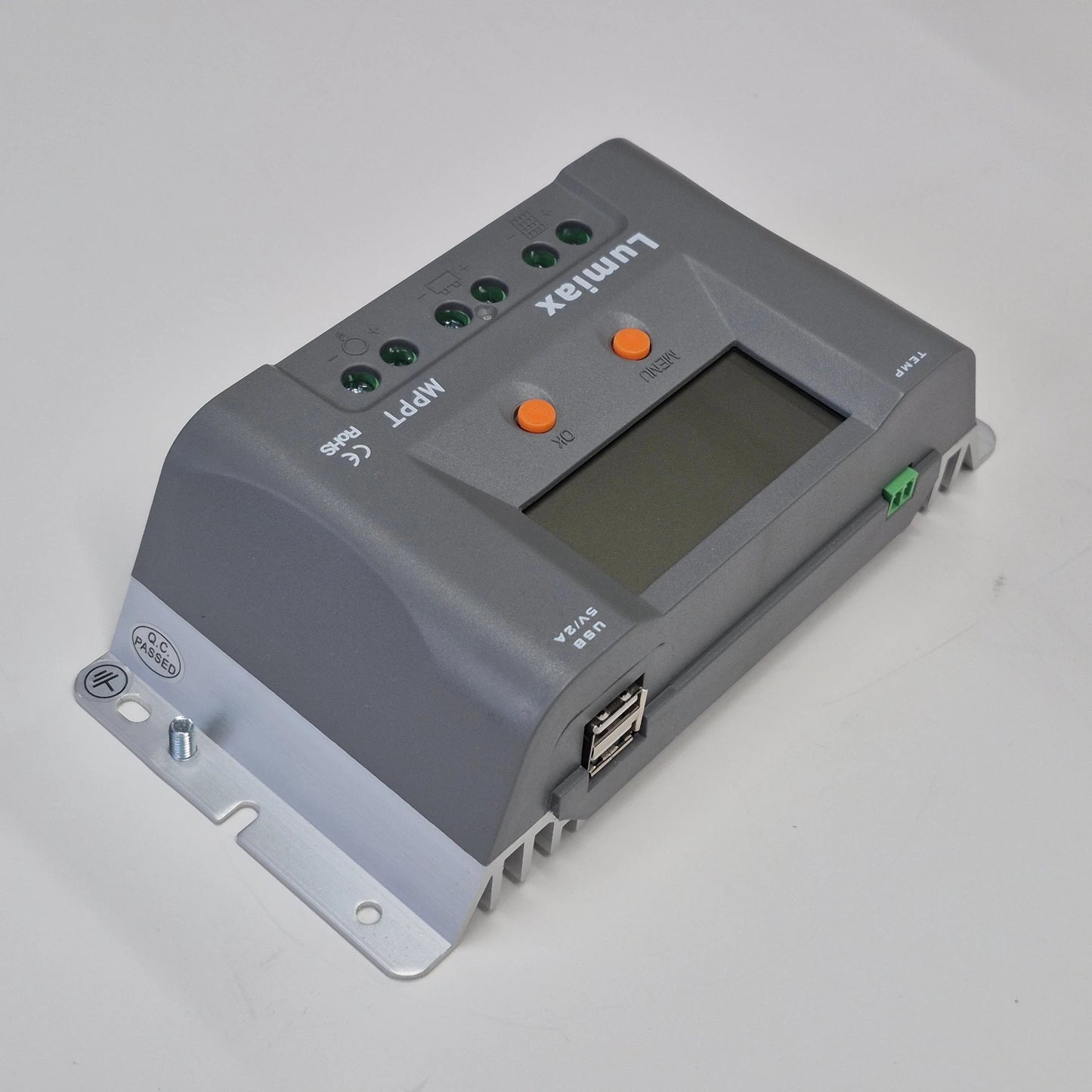
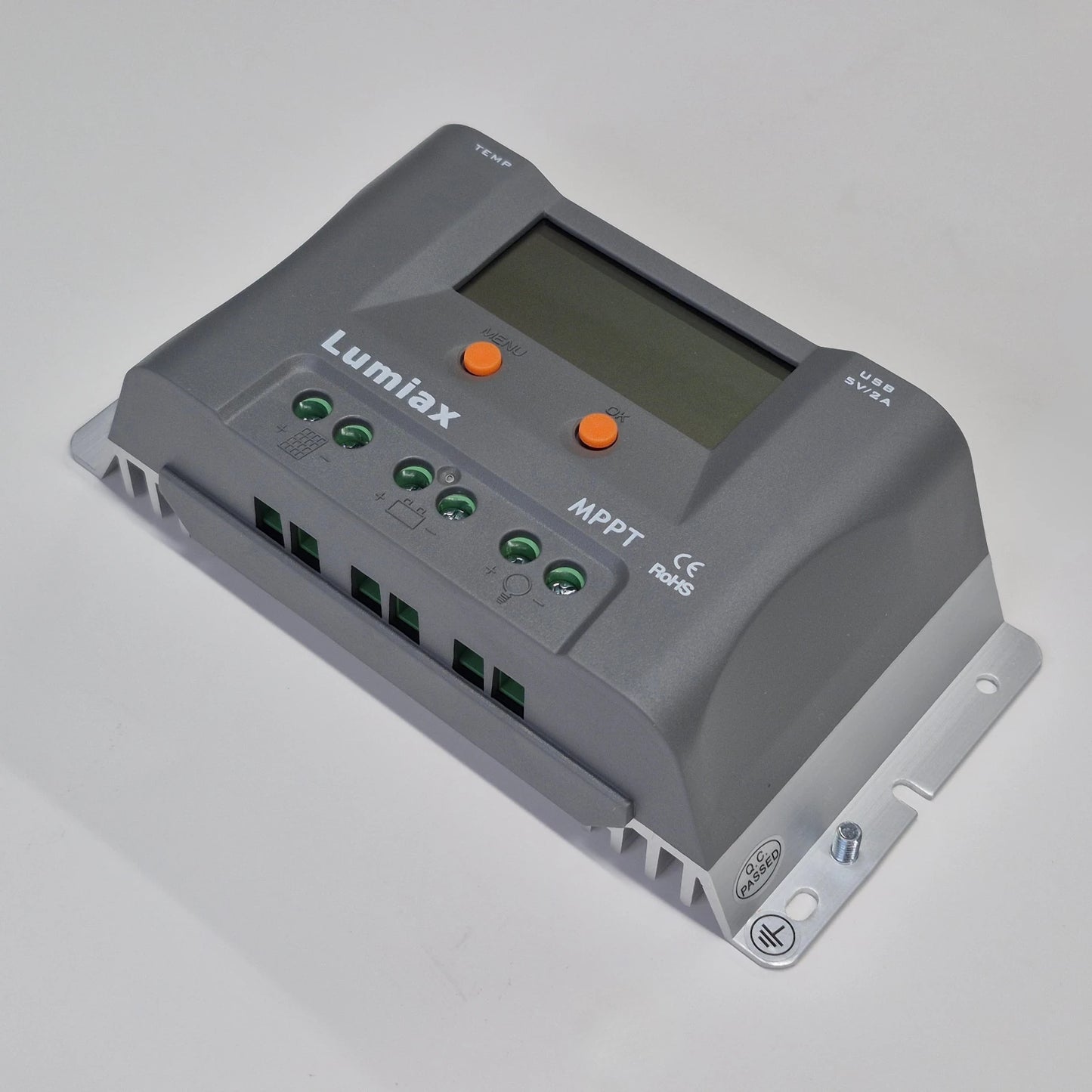
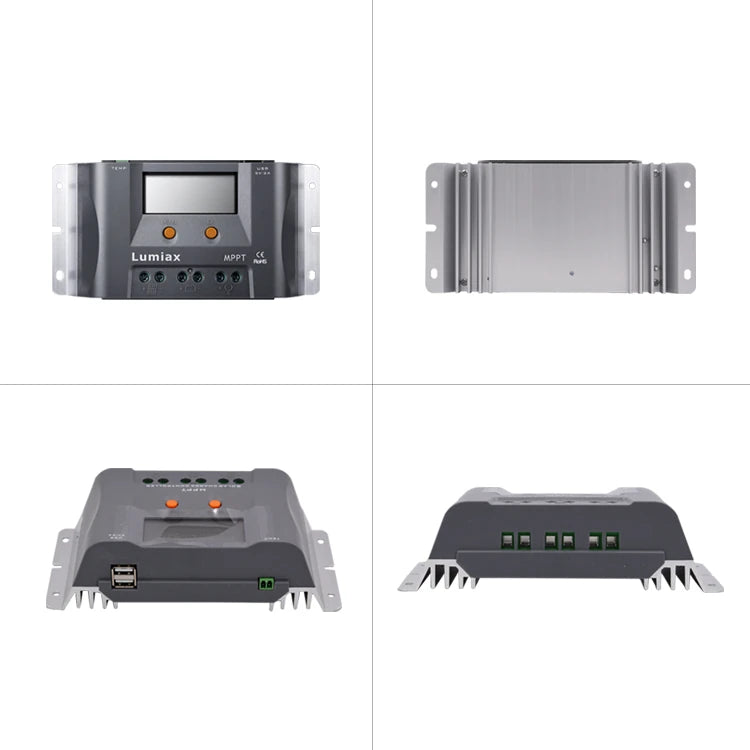
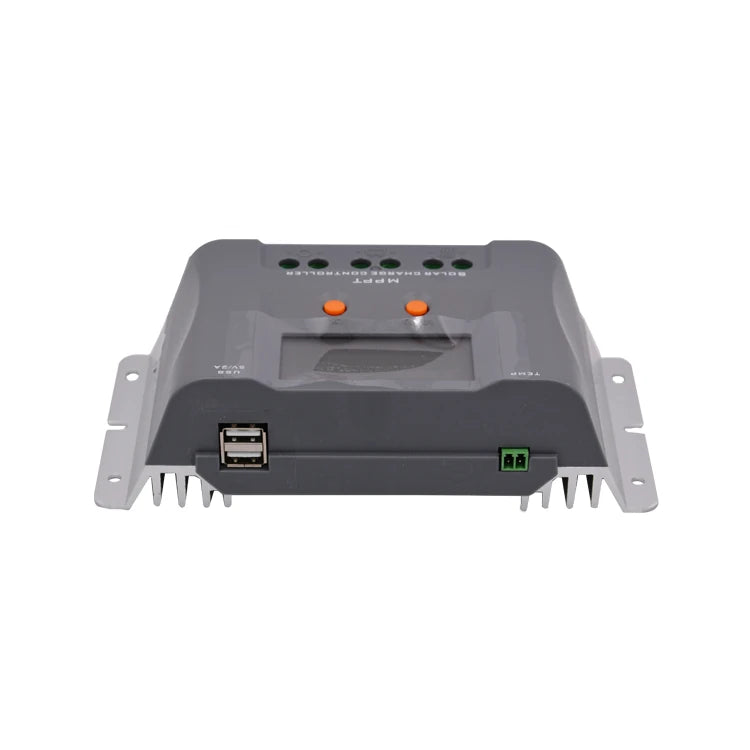
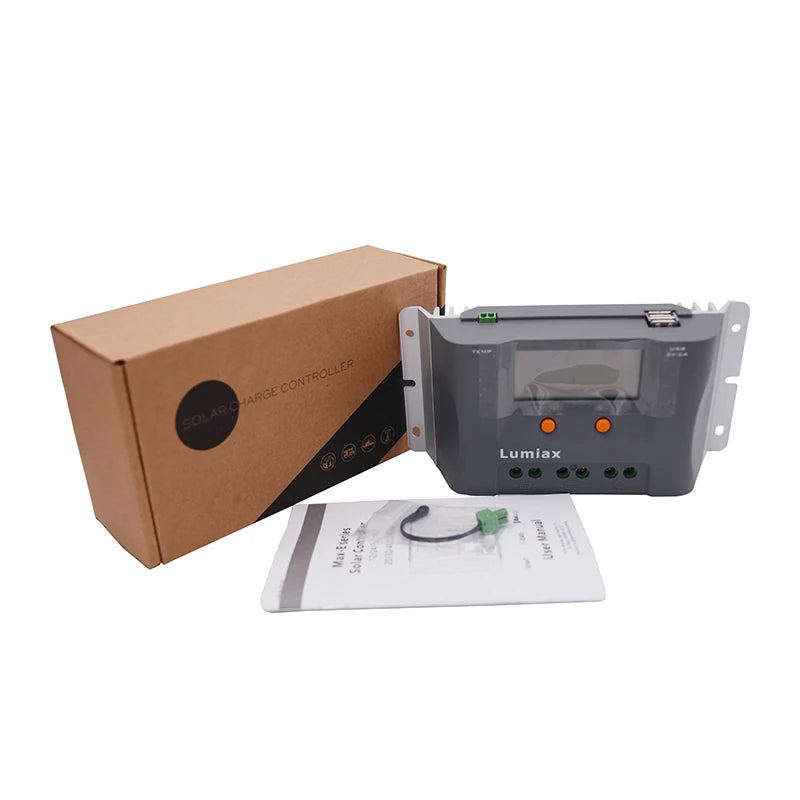
Why You’ll Love It
|
Higher Efficiency
MPPT tracking extracts up to 30% more power from your solar panels compared to older PWM controllers. |
|
Lithium Compatible
Optimized charging profiles for LiFePO₄, AGM, Gel, and Flooded batteries ensure long battery life and safe operation. |
|
Built-In LCD
Real-time monitoring of system status without the need for extra meters or displays. |
|
USB Charging
Dual USB ports make it easy to charge phones, tablets, and small devices directly from your solar setup. |
|
Built-In Protection
Safeguards your system against over-voltage, reverse polarity, short circuits, and overheating. |
Overview
The MT1550-EU is a compact 15 A MPPT solar charge controller for small 12 V off-grid systems. With support for up to 200–220 W of solar input, it’s a natural fit for builds using two 100 W panels or a single 220 W Lumera panel. Despite its size, it delivers professional-grade maximum power point tracking so you get more energy from the same roof space.
Did you know? Switching from PWM to MPPT can boost usable energy by up to ~30%—a big win for vans, RVs, cabins, and sheds where panel space is limited.
Efficient Charging Technology
Lumiax’s advanced MPPT algorithm continuously aligns panel output with battery needs, maximizing charge current into your bank. It’s tuned for modern LiFePO₄ batteries and equally compatible with AGM, Gel, and Flooded types. Multi-stage regulation (bulk, boost, equalization, float) supports healthy battery chemistry and long service life.
Result: faster charging, better energy harvest in variable conditions, and stable performance through temperature swings.
User-Friendly Design
A built-in LCD provides clear, real-time status without extra hardware. Dual USB ports make it easy to top up phones and small devices. The programmable load output supports multiple modes (always-on, dusk-to-dawn, user-defined) for lighting, pumps, or auxiliary circuits—handy control without a separate timer.
A popular pairing: two 100 W panels and a 100 Ah LiFePO₄ battery—enough to keep a fridge running, lights on, and devices charged for typical van/RV days.
Built for Reliability
Designed for long-term off-grid use with low self-consumption (~0.2 W), the MT1550-EU includes protections for over-voltage, short-circuit, reverse polarity, and temperature-related charging. Its IP32 enclosure and common-negative design simplify installation. Rugged terminals (up to 8 AWG / 10 mm²) ensure secure, low-loss connections.
Who It’s For
Ideal for mobile and light-duty off-grid power: van builds, overlanding rigs, RVs, backyard sheds, tiny cabins, boats, or emergency backup kits. It also works well for other small systems such as gate controllers, remote security cameras or communication gear where dependable solar charging is required.
If your energy needs grow, it’s easy to step up to a higher-capacity controller later. For compact systems, the MT1550-EU brings efficiency, safety, and simplicity together in one affordable package.
Applications
- Vanlife & small RVs — Pairs perfectly with 2×100 W or a single ~220 W panel to run a 12 V fridge, lights, fans, and device charging.
- Overlanding & car camping — Compact portable kits for coolers, radios, lights, and USB devices via the controller’s dual USB ports.
- Backyard sheds & outbuildings — Add lighting, chargers, motion sensors, and Wi-Fi without pulling AC to the building.
- Tiny cabins & off-grid retreats — Light-duty 12 V systems for essentials (lights, comms, chargers) with efficient MPPT harvest.
- Boats & marine — Keep house batteries topped up for pumps, nav electronics, and anchor lights between trips.
- Emergency backup — Maintain a 12 V battery and keep phones/routers online during outages with a small PV + battery kit.
- Ham radio & comms — Stable 12 V supply and programmable load output for radios and auxiliary gear.
- Gate controllers — Reliable charging through seasons; use load modes for dusk-to-dawn or timer behavior.
- Remote security cameras — Power IP/PoE cameras + LTE/5G router at gates, farms, and sites.
- Solar lighting & signage — Built-in “street-lamp” and timer modes reduce extra hardware.
- DIY power boxes — Drop into compact 12 V battery boxes with one or two panels.
Performance in Real-World Setups
 High-efficiency MPPT squeezes more energy from limited roof space — ideal for compact 12 V systems.
The MT1550-EU’s MPPT algorithm maximizes harvest from small arrays, making modest kits feel bigger in variable sun and partial shade. A highly practical pairing is
2×100 W in parallel (or a single ~220 W panel) feeding a 12 V LiFePO₄ bank — plenty for a DC fridge, lighting, and daily device charging in a compact rig. USB charging and a clear LCD make day-to-day use simple, while the programmable load output can run lights or auxiliary circuits on schedules.
High-efficiency MPPT squeezes more energy from limited roof space — ideal for compact 12 V systems.
The MT1550-EU’s MPPT algorithm maximizes harvest from small arrays, making modest kits feel bigger in variable sun and partial shade. A highly practical pairing is
2×100 W in parallel (or a single ~220 W panel) feeding a 12 V LiFePO₄ bank — plenty for a DC fridge, lighting, and daily device charging in a compact rig. USB charging and a clear LCD make day-to-day use simple, while the programmable load output can run lights or auxiliary circuits on schedules.
Designed for dependable service, the controller features common-negative wiring, IP32 enclosure, low self-consumption (~0.2 W), and protections for over-voltage, reverse polarity, short circuit, and thermal events. An external temperature sensor is included in the package for more accurate charging across seasons. In healthy, right-sized arrays (≤ ~200 W), it sustains useful bulk-charge current without unnecessary bulk or cost.
Install & Sizing Tips
System voltage: 12 V fixed. Controller limit: 15 A charge current, max PV power ~200 W. PV voltage limit: Voc ≤ 35 V (at the coldest site temperature). Because of the 35 V Voc cap, wire two 100 W panels in parallel (not series) unless you’ve verified the cold-weather Voc stays below the limit. Keep cable runs short, size conductors appropriately, and mount in a sheltered, ventilated location.
Slight over-paneling can actually improve performance in shoulder seasons and darker months — for example, pairing with a single Lumera 220 W panel helps maintain better daily harvest even under cloudy or low-sun conditions.
Use the LCD for quick checks; dual USB ports provide 5 V device charging. Configure the load output (always-on, dusk-to-dawn, user timer) as needed, and connect the included temperature sensor for temperature-aware charging. Set targets to your battery maker’s specs (e.g., typical LiFePO₄ absorb around 14.4 V); confirm the battery can accept a 15 A charge rate.
Key Features
- >99.9% MPPT tracking efficiency for maximum solar harvest
- Optimized charging profiles for LiFePO₄, AGM, Gel, and Flooded batteries
- Integrated LCD display for real-time status and setup
- Dual USB outputs for phones, tablets, and small electronics
- Programmable load output with multiple control modes
- Supports external temperature sensor for precise charging
- Low self-consumption design with IP-rated protection
Performance You Can Trust
Lumiax’s MPPT charge controllers are engineered to deliver consistent, reliable power management for your solar system. By continuously tracking the optimal voltage and current point of your panels, these controllers can boost charging efficiency by up to 30% compared to traditional PWM models — meaning more usable energy every day, even in cloudy or shaded conditions.
Designed with modern LiFePO₄ batteries in mind, but fully compatible with AGM, Gel, and Flooded options, the MT series ensures safe multi-stage charging that maximizes performance and extends battery life. Built-in protections guard against over-voltage, short-circuit, and reverse polarity, giving you peace of mind in every installation.
With practical touches like an LCD display, dual USB ports, programmable load output, and support for a remote temperature sensor, Lumiax makes advanced solar charging simple. Whether you’re powering an RV, van build, small cabin, or off-grid system, these controllers combine efficiency, safety, and user-friendly design into one compact unit.
Technical Specifications — MT1550-EU
| System | |
| System Voltage | 12 V (fixed) |
| Max Charging Current | 15 A |
| Battery Types | Gel, AGM, Liquid, LiFePO₄, Lithium (programmable) |
| Grounding | Common Negative |
| Solar PV Input | |
| Max PV Input Power | 200 W |
| Max PV Voltage (Voc) | 35 V (at min ambient temp) |
| MPPT Tracking Range | (Battery V + 1.0 V) → 0.9 × Voc |
| Charging Performance | |
| MPPT Tracking Efficiency | > 99.9 % |
| Charge Conversion Efficiency | ≈ 97.5 % |
| Lead-acid Voltages @25 °C | Boost 14.5 V · Equalize 14.8 V · Float 13.7 V |
| Protections (Lead-acid) | Over-charge 15.5 V · LVD 10.8–11.8 V (default 11.2 V) |
| Temp Compensation | –4.17 mV/K/cell (Boost/Equalize); –3.33 mV/K/cell (Float) |
| Lithium (Programmable) | Target 10.0–17.0 V (default 14.4 V) Low Volt Disc. 9.0–15.0 V (default 10.6 V) |
| Outputs & Interface | |
| Load Output | 15 A max; modes: Always-on / Street-lamp / User |
| USB | 2 × USB, 5 V up to 2 A total (1.5 A single); disabled in LVD |
| Display | LCD |
| Communication | None |
| Remote Temperature Sensor | Included (may require extension) |
| Physical & Environmental | |
| Dimensions / Weight | 189 × 96 × 53 mm · 420 g 7.4 × 3.8 × 2.1 in · 0.9 lbs |
| Terminals | Power terminals 8 AWG (10 mm²) |
| Protection Degree | IP32 |
| Self-Consumption | ~ 0.2 W |
| Operating Temp | –20 °C → +55 °C (storage –25 °C → +80 °C) |
| Humidity / Altitude | 0–100 % RH · up to 4000 m |
Solar FAQ
About Solar Charge Controllers
What does a solar charge controller do?
It prevents overcharging, regulates voltage, and ensures your battery bank charges in a safe, controlled way. Without one, solar panels could damage a battery by pushing in unregulated power.
At Sapphire, controllers are chosen to match our LiFePO₄ batteries perfectly, so you get maximum performance and lifespan from all of your gear.
What is the difference between MPPT and PWM?
This works ok for lower voltage arrays, but wastes a significant amount of energy on higher voltage panels, and potentially risks damage to control circuits on the batteries. PWM is lower cost, but lower efficiency.
MPPT (Maximum Power Point Tracking) controllers do exactly what the name implies. They use advanced electronics and actively adjust their behavior to pull the most power possible from your PV array. This is accomplished by actually transforming the excess voltage, into current that can be funneled directly into your battery system.
This boosts efficiency by up to 30%, and makes higher voltage arrays possible, reducing wiring costs. MPPT is almost always worth it. See our blog posts for deeper dives into MPPT vs PWM.
How do I size a solar charge controller?
View our Solar Panels and Charge Controllers
Can I use a solar charge controller with LiFePO₄ batteries?
Many modern controllers include lithium charging profiles built in.
How much solar can I connect to my controller?
Moderate oversizing is fine—the controller will “clip” excess power—but never exceed its voltage rating. Check the Voc ratings on your panels, and be aware that colder temperatures will increase the panel output voltage. Leave yourself a margin so you're not stressing your controller.
When in doubt, it's always better to have a controller that is rated for more than you're connecting. It will help the controller run cooler, longer.
Do I need an inverter with a solar charge controller?
The solar controller's job is to manage DC charging only. What you do with that newly charged battery power is up to you.
To power AC appliances like microwaves, laptops, or TVs, you’ll need an inverter.
Can I mix different solar panels with one controller?
Best practice is to use matched panels.
What protections are built into solar charge controllers?
Are solar charge controllers waterproof?
Some of our RV controllers are IP54 giving you excellent dust and water protections, and there are IP65 models available for fully outdoor installations.
Generally though, it's best practice to mount the controllers inside a clean, cool, dry space. If you're note sure, contact us and we're happy to help.
What accessories should I use with my controller?
Sapphire offers disconnect switches and accessories designed to work with our batteries and controllers.
How long does a solar charge controller last?
Our MPPT units are designed for long-term reliability to match the service life of our Solar Panels, and our LiFePO₄ batteries.
What are common applications?
Controllers are commonly used in van builds, RVs, cabins, boats, tiny homes, and emergency backup power kits. They’re also great for specialized uses like powering security cameras or farm gates.
See our Blog Articles for ideas and more information
About Solar Panels
What size solar panel do I need?
Start with discovering your daily power needs, cross checked with your battery sizing. See our article about sizing your battery for a good place to get started.
Can I connect multiple solar panels together?
Be sure to consider the limitations of your charge controller when adding more solar.
What happens if I oversize or undersize my solar array?
Under sizing will leave batteries undercharged, and you may struggle to keep the lights on. This may require you to augment your battery charging with things like DC-DC Engine Charging, Shore Power, or a generator.
What is the difference between monocrystalline and polycrystalline panels?
Polycrystalline panels are sometimes slightly cheaper, but are an obsolete technology and it is recommended to avoid new installs using these.
Do solar panels work in cloudy weather or winter?
MPPT controllers can help maximize energy, even in sub-optimal conditions. Many people will "over panel" when they expect low production.
How long do solar panels last?
Are solar panels waterproof and durable?
What maintenance do solar panels need?
When washing, use a non abrasive brush/cloth and a gentle soap.
Use a soft edged brush, or wiper, to remove snow and ice. Avoid hitting/impacts or using heat.
Can I install solar panels myself?
What angle or direction should solar panels face?
Flat mounting on vans and RVs works too, but expect lower winter performance. Tilting mounts can boost output, but require you to stow the panels before moving.
Buying & System Design
How do I calculate how much solar I need?
Ideally, you want to have more solar than you use in a day, so you can "catch up" after a couple of cloudy days.
For help, see our off-grid battery sizing guide.
What size battery bank should I pair with my solar panels?
Figure out your daily usage, then multiply for the number of days you want to run without charging.
After that it's just a matter of picking your batteries out. Our batteries are listed with their Watt hour (Wh) capacities to help make this easier.
See our article on battery sizing to help get a better understanding.
Do I need both a solar charge controller and an inverter?
The inverter converts DC to AC so you can run household devices. Off-grid systems use multiple components together: Solar panels + MPPT controller + Sapphire LiFePO₄ battery + Inverter.
What safety equipment do I need for a solar setup?
Sapphire carries battery disconnect switches and wiring accessories tested to handle high current safely.
Can solar power run my entire house or RV?
Reach out to us with your goals and we can help guide you!
What solar setup is best for vans, cabins, or sheds?
Vans: Usually 100–400W of panels + 100–300Ah LiFePO₄ battery.
Cabins: 400–1000W panels + 200–600Ah battery.
Sheds: 100–200W with 100Ah battery (more if you want to run tools)












